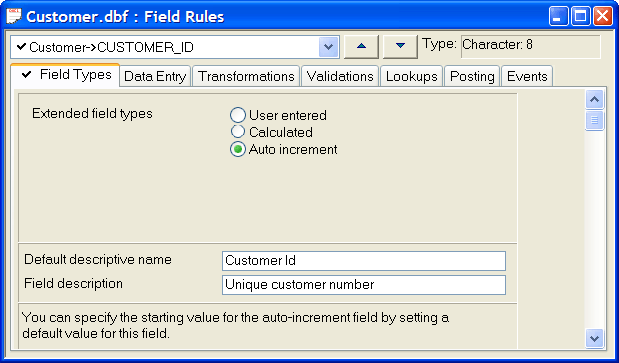Field Rules: Field Types
Description
Topics include: Extended Field Types, User-Entered Fields, Calculated Fields, Auto-Increment Fields, Examples of Auto-increment Fields, Default Descriptive Name, Field Description, Deleting a Calculated Field
Extended Field Types
The Field Types tab of the Field Rules Editor lets you define basic formatting and options for a field.
There are three types of fields
User-Entered Field: The user enters a value for the field.
Calculated Field: Alpha Anywhere automatically calculates field values.
Auto-Increment Field: Alpha Anywhere assigns incrementing field values as records are entered.
User-Entered Fields
The default field type is user-entered, which relies on the user for a field value.
Calculated Fields
A Calculated Field Rule calculates a table field's value when you enter or change data. Refer to Calculated Fields for more information.
For example, you might use a calculated field to calculate membership expiration dates. If you have a user-entered field called START_DATE, you can assign another field called EXP_DATE the following calculated field expression:
MEMBER->START_DATE + 365
This returns an expiration date that is one year after the starting date. The following example sets the fullname calculated field using the values in the firstname and lastname fields.
Auto-Increment Fields
When you define a character, numeric, or date field with an auto-Increment rule, an incremented value is automatically filled in when you create a new record, which you can accept or overwrite. If you overwrite the default value, successive records are incremented from the value you enter. Auto-Increment fields are useful for assigning unique identification numbers for invoices, parts, products, and customers. By default, character fields are incremented using number characters (like "0001", "0002"). If you do not enter a value for the first record, Alpha Anywhere automatically starts a character field at "1". When a field is incremented, it follows the previous record's field conventions. For example, the value "A1" will be "A2" in the following field, then "A3" and so on. Additionally, you can increment both letter and number field values. The auto-increment field rule takes into account deleted records.
When you create an auto-increment field rule, Alpha Anywhere creates an index on the field. This ensures that auto-increment field values can never be duplicated.
In the Control Panel select the table and click Table > Edit Field Rules.
On the Field Types tab in the Extended field types group, click the Auto increment radio button.
Optionally, change the Default descriptive name for this calculated field.
Optionally, change the Field description.
To provide an initial value for the field:
Display the Data Entry tab.
Change Default mode to "Simple default expression".
Enter the initial auto-increment value (or a value produced by an expression) in the Default value field. The value must be the same data type as the table field. Click 'xy' to use the Expression Builder to help you define the value.
Examples of Auto-increment Fields
- Base Expression
- Sequence Generated
- 12345
12346, 12347, 12348 ... 99999, 00000
- "0000000"
"00000001", "00000002", "00000003", ... "99999999", "00000000"
- "ABC"
"ABD", "ABE", "ABF", ... "ZZZ", "AAA"
- "ABC-0001"
"ABC-0002", "ABC-0003", "ABC-0004", ... "ABC-9999", "ABD-0000"
Default Descriptive Name
Use Default Descriptive Names when you want to provide longer, helpful descriptions of fields for users. Default Descriptive Names replace standard field labels on layouts. For example, if a table has a field called CUSTOMER_NUMBER, you could change the Default Descriptive Name to "Customer ID#." Alpha Anywhere displays "Customer ID#" as field labels on forms and browses, but the actual field name is still CUSTOMER_NUMBER. Default Descriptive Names can be especially useful if you create several layouts for a table. You only type in a Default Descriptive Name once, rather than editing field labels for every layout.
Field Description
Text entered in the Field Description appears in the Status Bar (below the window bar, at the bottom of the Alpha Anywhere screen) when a field is selected on a form. If the Field Description does not appear, make sure Status Bar is checked on the View menu.
Deleting a Calculated Field
To delete a calculated field rule you must:
Erase the Calculated field expression text box.
Select the Extended field types User entered radio button.
See Also
